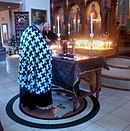Holy Wednesday facts for kids
Quick facts for kids Holy Wednesday |
|
|---|---|

Holy Wednesday procession in Villarreal, Spain (2015)
|
|
| Also called | Spy Wednesday Good Wednesday Holy and Great Wednesday |
| Observed by | Christians |
| Type | Christian |
| Significance | commemorates the Bargain of Judas and the Parable of the Two Debtors |
| Observances | Mass; Tenebrae |
| Date | Wednesday before Easter |
| 2024 date |
|
| 2025 date |
|
| 2026 date |
|
| 2027 date |
|
| Frequency | annual |
| Related to | Holy Week |
Holy Wednesday is a special day for Christians. It is also called Spy Wednesday or Good Wednesday in Western Christianity. In Eastern Christian churches, it is known as Great and Holy Wednesday. This day is part of Holy Week, which is the week right before Easter.
On Holy Wednesday, Christians remember two important events. One is when Judas Iscariot, one of Jesus's disciples, secretly agreed to betray Jesus. The other is when a woman named Mary anointed Jesus with expensive oil. Many churches hold a special service called Tenebrae on this day.
Contents
Stories from the Bible
In the New Testament, the Bible tells us what happened on Holy Wednesday. After Palm Sunday, religious leaders planned to kill Jesus before the Passover feast.
On the Wednesday before his death, Jesus was in a village called Bethany. He was having supper at the house of a man named Simon the Leper. While Jesus was at the table with his disciples, a woman named Mary came. She poured very costly oil on Jesus's head and feet.
Some of the disciples were upset. They asked why the oil was not sold to help the poor. But Judas Iscariot wanted the money for himself. Soon after, Judas went to the religious leaders. He offered to hand over Jesus to them for money. From that moment on, Judas looked for a chance to betray Jesus.
Because Judas secretly planned to betray Jesus on this day, it is sometimes called "Spy Wednesday." The word "spy" here means a hidden plan or trap. Judas acted like a spy among Jesus's followers.
Church Services
What is Tenebrae?
Many Christian churches hold a service called Tenebrae on Holy Wednesday. The word Tenebrae comes from a Latin word meaning darkness. During this service, candles are slowly put out one by one. This makes the church darker and darker.
The service includes readings about the Passion of Jesus, which is the story of his suffering and death. At the end, there is often a loud noise called a strepitus. This noise can represent the confusion and fear when Jesus died. It also reminds people of the earthquake mentioned in the Bible.
Catholic Church
In the Catholic Church, the Tenebrae service is often held on Spy Wednesday. It helps people think about the darkness and sadness of Jesus's final days.
Methodist Churches
Many Methodist Churches also observe the Tenebrae service on the evening of Spy Wednesday. It is a time for prayer and reflection.
Anglican Churches
Churches in the Anglican Communion, like the Protestant Episcopal Church in the United States, also celebrate the Tenebrae service on Spy Wednesday.
Byzantine Rite
In the Byzantine Rite (used by Eastern Orthodox Churches), Holy and Great Wednesday has two main themes. It remembers the sinful woman who anointed Jesus. It also remembers Judas Iscariot's agreement to betray Jesus.
A special hymn called the Hymn of Kassiani is sung during services. This hymn was written in the 9th century. It tells the story of the woman who washed Jesus's feet. The hymn is very emotional and helps people feel closer to the story.
In some places, like Greece, church members receive Holy Unction on Wednesday evening. This is a special blessing with oil.
Because Judas agreed to betray Jesus on this day, Orthodox Christians often fast (don't eat certain foods) on Wednesdays throughout the year. They also fast on Fridays.
Customs Around the World
- Czech Republic: This day is called Ugly Wednesday or Soot-Sweeping Wednesday. In the past, people would clean their chimneys on this day to get ready for Easter.
- Malta: This day is known as L-Erbgħa tat-Tniebri, which means Wednesday of Shadows. This name refers to the darkness of the Tenebrae service. Children used to drum on chairs in church to make a loud noise, like the strepitus.
- Scandinavia: This day is called Dymmelonsdagen. A dymbil is a piece of wood. Historically, the metal clappers of church bells were replaced with these wooden pieces. This made the bells sound duller and quieter on Holy Wednesday.
See also
 In Spanish: Miércoles Santo para niños
In Spanish: Miércoles Santo para niños



